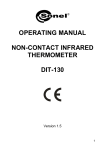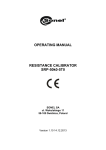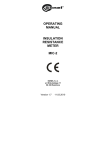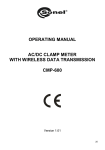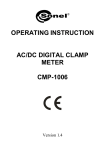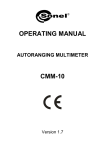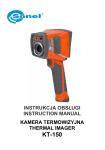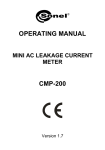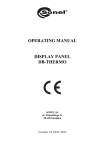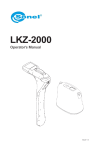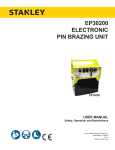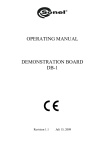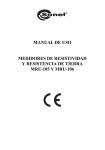Download User Manuals
Transcript
OPERATING MANUAL
CORONA CAMERA
UV-260
Parts of camera:
1)
2)
3)
4)
TFT display, tilted
Lens,
Keyboard,
Cover for inputs and battery
compartment
5) Holder for straps
Camera interface:
Video output
Audio input
Charging indicator
Charger socket
SD memory
card
Battery
compartment
OPERATING MANUAL
CORONA CAMERA
UV-260
Version 1.01 20.05.2014
UV-260 Corona Camera is a device for detecting and precise locating corona discharge
occurring in devices under high voltage. It helps to locate and determine the power of a discharge,
basing on UV radiation released during corona discharge and providing a reliable way of technical
assessment of high voltage equipment.
The camera allows user to overlay recorded images of the corona onto the visible image.
Images are displayed in real time on a TFT screen. Displayed image may be stopped and saved as
a still image; observed discharge may be also recorded as a video file. Recorded images and
videos are stored on a removable SD card in a format compatible with personal computers.
Main features of UV-260:
high, adjustable UV sensitivity,
automatic or manual focus adjustment for real image and UV image
combining real images and UV images
automatic reduction of noise and interference,
5.7" TFT touch screen,
insensitivity to solar radiation during the operation,
UV discharge detection alarm,
built-in GPS system,
precise location of UV discharge sources,
recording discharges with real image in the form of photos or videos that may be played on a
PC,
a program for generating reports -included in the set
2
Corona Camera UV-260 Operating manual.
CONTENTS
1.
2.
3.
Introduction. ....................................................................................................... 5
Safety. ................................................................................................................ 5
The principle of the operation. ............................................................................ 6
3.1.
Electromagnetic radiation: visible, infra-red, ultraviolet. ............................ 6
3.2.
Mechanism of corona discharge. ............................................................... 6
3.3.
Why corona discharge? ............................................................................. 8
3.4.
Detection of corona discharge. .................................................................. 8
4. Preparing the camera for operation.................................................................. 10
4.1.
External design of the camera. ................................................................ 10
4.2.
Mounting on a tripod. ............................................................................... 10
4.3.
Moving the camera. ................................................................................. 11
5. Ports and buttons. ............................................................................................ 13
5.1.
External ports. ......................................................................................... 13
5.2.
Layout and functions of buttons ............................................................... 14
5.2.1. Navigation buttons. ............................................................................. 14
5.2.2. Operating mode buttons...................................................................... 15
5.2.3. Control of power supply / charging and alarm - corona discharge
indicator .............................................................................................. 15
6. Operation and battery charging. ....................................................................... 15
6.1.
Inserting the battery ................................................................................. 15
6.2.
Charging the battery. ............................................................................... 15
6.3.
Guidelines for using the battery. .............................................................. 16
7. Working with UV-260 camera........................................................................... 16
7.1.
Operation of the buttons. ......................................................................... 17
7.1.1. Recording a video. .............................................................................. 17
7.1.2. Recording a static image..................................................................... 18
7.1.3. Switching the image mode. ................................................................. 18
7.1.4. "Freezing" displayed image. ................................................................ 18
7.1.5. Changing the focus mode. .................................................................. 18
7.1.6. Gain adjustment. ................................................................................. 18
7.1.7. Zoom. .................................................................................................. 18
7.1.8. Manual focus....................................................................................... 19
7.1.9. Zooming in. ......................................................................................... 19
7.1.10.
Playing a voice note........................................................................ 19
7.1.11.
Zooming UV+ image. ................................................................... 19
7.2.
Operating the menu ................................................................................. 19
7.2.1. Main menu. ......................................................................................... 19
7.2.2. Image Settings. ................................................................................... 20
7.2.3. Video ................................................................................................... 21
7.2.4. Image. ................................................................................................. 21
7.2.5. System. ............................................................................................... 21
Corona Camera UV-260 Operating manual.
3
7.2.6. Sub-menu "System Settings" .............................................................. 22
"Sonel UV Analyse" software. .......................................................................... 24
8.1.
System Requirements ............................................................................. 24
8.2.
Installing the software. ............................................................................. 24
8.3.
Starting the program. ............................................................................... 26
8.4.
Main window of the program. .................................................................. 26
8.5.
Main menu............................................................................................... 27
8.5.1. Records............................................................................................... 27
8.5.2. Image. ................................................................................................. 28
8.5.3. Video. .................................................................................................. 28
8.5.4. View. ................................................................................................... 28
8.5.5. Default settings ................................................................................... 30
8.5.6. Language. ........................................................................................... 31
9. Other information. ............................................................................................ 31
9.1.
Cleaning and maintenance. ..................................................................... 31
9.2.
Storage .................................................................................................... 31
9.3.
Dismantling and Disposal. ....................................................................... 32
9.4.
Transport ................................................................................................. 32
10.
Technical specifications. .............................................................................. 33
11.
Accessories. ................................................................................................ 34
12.
Manufacturer................................................................................................ 35
8.
4
Corona Camera UV-260 Operating manual.
1.
Introduction.
Thank you for choosing UV-260 camera.
UV-260 Corona Camera is a modern, high-quality tool, easy and safe to use. To prevent errors
and problems while operating the device, carefully read this manual before the first use.
This manual contains three types of warnings that describe the possible risks both for the user
and the device. Information starting with word "WARNING" describe situations, which may
endanger user's life or health, when instructions are not followed. Word "CAUTION!" begins a
description of a situation, which may result in device damage, when instructions are not followed.
Indication of possible problems is preceded by word "Note".
The device has been designed, developed and manufactured in accordance with ISO 9001
quality systems.
We reserve the right to introduce changes that modernize the device.
Copyright of this manual and software are the property of Sonel SA
2.
Safety.
WARNING:
Do not attempt to open the device, as none of the components can be repaired or
calibrated by the user. Any maintenance activities may be carried out only by
authorized service personnel.
NOTE
Avoid strong shocks and stroking the device during its handling and transportation.
NOTE
Targeting the lens at objects that emit very high temperature (e.g. the sun), also when
switching the device ON/OFF may damage it.
NOTE
Never touch the lens. Dust accumulated on the lens may be removed only by using special
tools or compressed clean air.
The camera should be stored in cool, dry place, away from sources of strong electromagnetic
fields. When the camera is not used for a long time, remove the batteries.
During operation, the camera should be securely fastened, as all vibrations adversely affect the
accuracy.
Corona Camera UV-260 Operating manual.
5
WARNING:
Using the device with a damaged housing is a threat to the health and life of the user.
When working with the device, observe the technical conditions specified in this manual.
Damage to the camera, resulting from improper use, alteration and obvious negligence are not
covered by the guarantee.
3.
The principle of the operation.
Corona discharge is one of the three distinguished types of partial discharges i.e. breakdowns
caused by high voltage, which does not cause a short circuit. In addition to the corona discharge
(the least harmful of partial discharges), there are surface discharges, related mainly to
contaminated insulator surface and internal discharges caused by the degradation of the internal
insulation.
3.1.
Electromagnetic radiation: visible, infra-red, ultraviolet.
Individual types of electromagnetic radiation have wavelengths as shown in Figure 1.
Gamma Rays
X-Rays
, Visible radiation
Infrared
, Ultraviolet
Microwaves
Radio waves
Thermal camera
UV camera
Figure 1: Electromagnetic waves of different lengths.
3.2.
Mechanism of corona discharge.
Corona discharge is a current flow, usually in the air, from a discharge electrode which is under
high voltage.
High voltage is a source of air ionization, which creates plasma around the electrode - it is
ionized matter containing electrically charged particles. The resulting ions carry the load to places
of lower potential.
6
Corona Camera UV-260 Operating manual.
If the discharge electrode, which may be any object under high voltage, has a proper
"sharpened" shape, then a high potential gradient is generated around this part generates, which
may lead to a discharge. At very high voltage it may be a spark or arc - if a 'plasma channel' is
created. In contrast, corona discharge is formed when a voltage that causes ionization is too low at
the moment to create the plasma channel.
The discharge is invisible in daylight (in total darkness - rarely occurring in outdoor conditions it is hardly visible as a blue-violet afterglow), as most of the radiation generated is in the ultraviolet
range, invisible to human eye, and therefore, the development of UV radiation detectors causes
gradual replacement of acoustic-based detection methods with UV-based detectors.
Corona discharges generate the electromagnetic spectrum in the range of 200…405 nm; solar
radiation also contains (in addition to visible light) both infra-red and ultraviolet radiation. Using an
appropriate filter (wavelength range of 240…280 nm) suppress UV radiation generated by the sun,
so the camera may operate well in daylight without interference.
Range filtered by the
camera
Solar radiation spectrum
Ultraviolet
Visible light
Wavelength (nm)
Fig. 2: The spectrum of corona discharge
Depending on the polarity of the discharge electrode, the corona discharge may be positive or
negative. In case of both negative and positive discharges, photons are the main source of
electrons. These photons are formed by induced atoms creating plasma, which return to lower
energy states, therefore the equipment is scaled in "UV photons."
Positive discharge is homogeneous, as the majority of charges are concentrated close to the
electrode. Negative discharge at the same voltage takes a larger area, but because the energy is
spread over the wider area, it seems to be weaker and it may be difficult to locate.
In practice, controlled corona discharges, are used for example in industry to remove dust in
the gases, air, or to remove unwanted electric charges (even in household air ionizers). Charges
are generated on certain surfaces and this phenomena may be observed in many everyday items
e.g. a laser printer or photocopier.
Corona Camera UV-260 Operating manual.
7
3.3.
Why corona discharge?
Unwanted corona discharge influence adversely the devices, where they occur, for example by
causing radio interference (often problems with the reception of radio signals near high voltage
power lines), or by causing a loss of energy (energy "escapes" to the air). The most adverse effect
of corona discharges, is the impact on the insulation elements, resulting in the need to disconnect
entire power transmission systems. Therefore, it is required to prevent corona discharges and
reduce them at their early stage, as the next stage results in creating an arc and permanent
damage.
Even the presence of small discharges in one place may cause adverse effects, because the
current flow and contamination generate corrosive substances, which deteriorate the condition of
insulators, enable the moisture access to the internal components and accelerate degradation.
Locating corona discharges is a useful cautionary measure, similarly to infra-red methods that help
to discover potential problems before they arise.
3.4.
Detection of corona discharge.
UV-260 detects and locates corona discharges by detecting the UV signal generated during the
discharge, then they can be counted to assess the level of discharge. In practice, the number of
discharges in a certain time is represented graphically - by so called 'UV image'. Precise overlay of
UV image on the real image provides an accurate and most importantly, safe (performed from a
distance) method of locating places where equipment degradation started, without the need to turn
off power of the tested facility.
Fig. 3, 4. Corona discharge in laboratory conditions.
8
Corona Camera UV-260 Operating manual.
Fig. 5-8. Corona discharge in real power grids.
Fig. 9, 10. Corona discharge and its effects.
Corona Camera UV-260 Operating manual.
9
4.
4.1.
Preparing the camera for operation.
External design of the camera.
UV-260 is a compact device, which is simple and ergonomic to use. It may be operated on a
tripod or used as a hand-held tool.
Arrangement of its individual elements is illustrated in Figures 11 and 12
1)
2)
3)
4)
TFT display, tilted
Lens,
Keyboard,
Cover for inputs
compartment
5) Holder for straps
and
battery
Fig. 11. Parts of Camera UV-260.
4.2.
Mounting on a tripod.
For long observations and in order to eliminate accidental vibration and shocks the camera can
be mounted on a tripod (Fig. 12).
In the bottom of the camera a suitable threaded opening is provided for mounting on a tripod
(standard thread for photographic tripods).
Note. The device should be firmly mounted (screwed) to a tripod to prevent accidental
damage.
10
Corona Camera UV-260 Operating manual.
Fig. 12 UV-260 mounted on a tripod.
4.3.
Moving the camera.
UV-260 may be used as a hand-held device, but it is much more convenient to use a strap
fixed to holders, enabling the operator to freely use hands during the operation (Fig. 13, 14).
CAUTION!
Fastening and unfastening of the strap must be carried out in the upright position of the
device (fig. 13), otherwise the camera may slip out of the holder, resulting in a drop and
damage.
Corona Camera UV-260 Operating manual.
11
Fig. 13. Fixing strap to the holders.
The camera suspended on the strap allows user easily operate the keyboard, as shown in
Figure 14).
Fig. 14. The camera mounted on the strap.
12
Corona Camera UV-260 Operating manual.
5.
5.1.
Ports and buttons.
External ports.
Camera interfaces (video output, audio input/output), charging indicator, power adapter input,
SD card slot and the battery compartment are located under the cover on the side of the camera
(Fig. 15).
Video output
Audio input
Charging indicator
Charger socket
SD memory
card
Battery
compartment
Fig. 15. Arrangement of ports under the cover.
Video output may operate in PAL or NTSC system.
The SD card must be formatted in FAT32.
When recording a voice note - approach maximally to the microphone. The microphone +
headphone set is plugged into the audio input located under the cover.
CAUTION!
When inserting the battery, pay attention to the correct polarity.
Voltage connected to power input cannot exceed 12V.
Corona Camera UV-260 Operating manual.
13
5.2.
Layout and functions of buttons
Fig. 16. Arrangement of the control panel buttons.
5.2.1.
Navigation buttons.
Buttons for menu operation and image functions:
- Up,
- Down,
- Left,
- Right,
- confirm,
- exit without confirmation.
In addition to menu navigation, functions of the buttons are as follows:
- "freezing" the displayed image,
- switching into the focus adjustment mode,
- playing a voice note
- zooming x1, x2, x4 in combined (mixed) image mode (real image +UV).
14
Corona Camera UV-260 Operating manual.
5.2.2.
Operating mode buttons.
- image display mode switch, repeated pressing of the button causes switching into the
following modes: UV image only - visual image mode - UV/visual mixed mode (UV image overlay
on the visible image).
- saving the still image,
- video recording,
and
- manual focus adjustment,
and
- zoom in/out
5.2.3.
Control of power supply / charging and alarm - corona discharge
indicator
- switching on / off,
- power indicator,
- corona discharge indicator.
6.
Operation and battery charging.
UV-260 is powered by a dedicated lithium-ion rechargeable battery, which should be charged
only with the charger included in the set. Any other batteries (even of the same shape) and other
chargers may present a risk of damage to the device and a danger to the user.
The battery may be also charged by the camera via AC adapter or a car adapter (12V) - both
included in the set.
When battery level is low, a message will be displayed on the screen, indicating the
need for recharging.
6.1.
Inserting the battery
Insert the battery into the battery compartment located under the cover for inputs and battery
compartment (Fig. 15).
6.2.
Charging the battery.
The battery may be charged using the external charger or by connecting the AC adapter (the
battery remains inside the camera) to the device using the input located slot under the battery
compartment cover 4 .
Corona Camera UV-260 Operating manual.
15
Charging in the external charger is indicated by red colour of charging indicator. Completed
charging process is indicated by green colour of charging indicator.
Charging inside the camera is indicated by red colour of the indicator, its completion by green
colour (Fig. 15).
Charging also takes place during operation of the camera.
WARNING.
At high temperatures do not turn on the camera while charging the battery, as it
may decrease battery life, or even cause fire.
6.3.
Guidelines for using the battery.
Charging of the batteries can take place only indoors - it is unacceptable charge them outside,
especially during rain, etc.
WARNING.
Do not short-circuit the battery, avoid accidental short circuits (e.g. when moving
the battery loose with other metal objects).
The battery should be stored at a temperature not exceeding 60°C.
When charging is finished, disconnect the external power supply adapter from the mains.
When replacing the battery, with the camera connected to the power supply adapter, first
connect the battery to the camera, and only then connect the AC adapter.
It is forbidden to use non-original batteries and chargers.
7.
Working with UV-260 camera.
In order to switch the camera on press and hold
button for approx. 2 seconds. The camera
starts by performing auto-tests for about 25 seconds, then it switches on the operating screen
(Figure 17).
16
Corona Camera UV-260 Operating manual.
Gain
Date, time
GPS coordinates
Amount of UV
photons
Frame - area for
counting discharges
Discharge
Focus mode
Battery indicator
Screen Mode (VIS,
UV, UV+)
Fig. 17. Working screen in mixed image mode - detecting corona discharges.
The screen, in addition to the image in the selected mode (real, UV, mixed), displays the
following information:
- current date and time,
- GPS coordinates of the measurement location,
- signal gain level
- battery charge status
- focus adjustment mode (auto or manual),
- image mode indicator: mixed UV+ , i.e. combined UV and visual image; visual image VIS ,
or UV image only: UV .
White frame on the screen is an area for photon counting (effective area), where discharges
are recorded - (amount of UV photons), the user may select 3 frame sizes - large, medium and
small.
7.1.
Operation of the buttons.
Below, we describe the operations available by pressing buttons in the working screen mode.
7.1.1.
Recording a video.
Press
to start recording a video and saving it on a SD card (real time recording of images
displayed on the screen). When recording video, you may add a voice note - after plugging the
microphone + headphones set into the audio input. Video is recorded in "avi" format, it may be
played both in the camera and on a PC.
Corona Camera UV-260 Operating manual.
17
7.1.2.
Recording a static image.
Press
to save the image displayed on the screen into the SD card.
When the image is recorded, the screen displays message "record a voice note", at this point,
you can record 20-second voice memo, press
to start voice recording (microphone connected
to the audio input) - then the image is saved and the camera returns to the real-time mode
(recording); press
to save the image without recording a voice note.
Note. For the best quality it is recommended to 'freeze' the image on the screen before saving
it - see below.
7.1.3.
Switching the image mode.
Use button
to switch displayed image into the following modes: visual image only VIS ,
discharge mode only ( UV ) and mixed mode ( UV+ ).
7.1.4.
Press
this point:
"Freezing" displayed image.
"freeze" the image, allowing you to make a decision about saving it into memory. At
- press
to save image to the SD card and return to detection mode in real time;
- press
again to return to the detection mode (real time) without saving the image.
7.1.5.
Changing the focus mode.
Press
to change the focus mode from manual to automatic and vice versa. By default, the
camera after starting is set to auto focus mode. In case of a complex image (objects at different
distances), focus may not be set automatically to the correct point (object), it is helpful to switch
into the manual focus mode.
7.1.6.
Gain adjustment.
In UV image mode or in mixed mode ( UV+ ) buttons
and
are used to increase or
decrease the sensitivity of the camera UV detector. Increasing the sensitivity results in displaying
both high and very low discharges, but also accidental interference; decreasing the sensitivity
allows the user to observe only high-power discharges, and thus precisely locate their source.
7.1.7.
Zoom.
In the visual image mode, use buttons
increasing the camera angle of view.
18
and
to zoom in/out the image by reducing or
Corona Camera UV-260 Operating manual.
7.1.8.
Manual focus.
In manual focus mode (see 7.1.5), use buttons
the image.
7.1.9.
to manually adjust the focus of
Zooming in.
In the image preview mode, press
enlarged, use buttons
real-time image mode.
7.1.10.
and
,
,
,
to zoom the image by 2x, 4x or 8x. When the image is
to navigate through the image. Press
to enter the
Playing a voice note.
When the image was saved with a voice note, it may be played in the image preview mode by
pressing
. In order to listen the voice note, you may use earphone + microphone set connected
to the audio input.
7.1.11.
Zooming UV+ image.
In mixed image mode UV+ and in UV mode, press
to enlarge (zoom) the image by 2x,
4x or 8x. This makes it easier to find physical damage of the observed object, by finding the most
radiant places.
7.2.
Operating the menu
UV-260 does not display the menu on startup. Enter the main menu by pressing
in the
real time image mode or after touching any place on the screen - the main menu is displayed;
press
or touch the screen in the place where menu is not displayed to close the menu.
Note. All the operations in the menu are performed by touching the individual items on the
screen in the drop-down menu sections or by navigating through the menu using the cursor keys.
Touching / selecting the options is simple and intuitive, therefore it is not described in details.
7.2.1.
Main menu.
With opened drop-down menu, select the desired option by touching the line where it is
displayed, or move the highlighted area in the menu with cursor keys
selection by pressing
. At any stage, you may press
or
, then confirm the
to exit the menu.
Corona Camera UV-260 Operating manual.
19
Fig. 18. Main menu.
7.2.2.
Image Settings.
Fig. 19. Menu – Image Settings.
"Image Settings" menu allows you to configure the mode effects of UV image display. Specific
options are presented below. Select/change options in the same way as in the main menu (use
"arrow" key and confirm by pressing
of the screen).
20
, exit to the previous menu by
Corona Camera UV-260 Operating manual.
; or touch selected area
Image mode: function analogous to pressing button
, select between Visible image, UV
image and Mixed image.
UV Image Color: select colour for displaying UV discharges (available colours: red, white and
blue).
Integral duration: recording UV signals takes place at a certain time, then the obtained value
is averaged, to filter out random interference.
UV discharges may occur (repeat) in the same places, in addition, especially when high
sensitivity is set on the detector, some random discharges appear (noise). Selecting the
appropriate averaging time for the gain level will provide the signals of the relevant discharge and
filter-out random signals (interference).
Gain: adjust the sensitivity of UV detector (similarly as adjustment - use buttons
and
in UV image mode UV or mixed mode UV+ ).
Note. Setting the high gain allows you to receive weak UV signals and detect very small
discharges, but it should be remembered that:
- large gain may affect the accuracy of locating discharges, as the UV image will cover large
area of the visible image making difficult to determine the exact location.
- in addition to the actual discharge signal, also interfering signals will be gained and they
usually appear in random places (not in the same location). Therefore, in the first phase of
discharge detection it is recommended to set a high gain level to preliminary determine the
discharge location, and then gradually reduce the gain to a level that will allow precise location of
discharges.
- for relatively large interferences, extend the averaging time and simultaneously reduce the
gain level - this will eliminate the noise (background) and accurately determine the appropriate
points of corona discharges.
UV overlay transparency: set the transparency of UV image overlaid onto the real image (0%
- opaque, 50% - translucent)
Photon counting box: select the area where discharges are counted (frame with 3 sizes:
large, medium, small).
Brightness: set the brightness level of the screen, depending on external conditions.
Exit: return to the main menu.
7.2.3.
Video
Provide a set of operations on video files saved on the SD card: view, delete files, and view
detailed information about recorded video files. File names correspond to the dates of their
creation.
7.2.4.
Image.
Viewing or deleting images saved on the SD card. While viewing images, you can zoom in and
play a voice note (if you previously recorded). Image file names correspond to the dates of their
creation.
The images are displayed in the form of a list or thumbnails.
7.2.5.
System.
After selecting "System" option, a sub-menu is displayed and the user may change:
Corona Camera UV-260 Operating manual.
21
- system settings (included in the next sub-menu, as described below),
- time settings,
- factory settings,
- format the SD card,
- display information about the SD card,
- display information about the system.
Fig. 20. System menu.
7.2.6.
Sub-menu "System Settings"
Fig. 21. "System Settings" Menu.
22
Corona Camera UV-260 Operating manual.
Language: Select the interface language.
Monitor: select system (PAL, NTSC) for the external screen.
Auto shutdown: the device is automatically turned-off, when no button is pressed during the
set time.
UV alarm: audible alarm after detecting UV discharge.
Phototn threshold: level of corona discharge (the amount of recorded photons), which triggers
the alarm.
Focus mode: selecting manual or auto focus (the same as pressing
Corona Camera UV-260 Operating manual.
button).
23
8.
"Sonel UV Analyse" software.
8.1.
System Requirements
Due to the large size of video files, you must provide enough disk space on your computer and
meet the following requirements:
- processor: CPU PENTIUM III; 1.4GHz CPU or better,
- memory: 256 MB or more,
- disk space: 20 GB or more,
- screen resolution: 1024×768 or more, the recommended resolution: 1600x900.
The software runs under Windows 7 or higher.
8.2.
Installing the software.
After starting the setup.exe file from the supplied CD or from software downloaded at
www.sonel.pl, perform standard installation procedure of software operating on MS Windows,
where you only need to specify or confirm the installation location on your computer:
24
Corona Camera UV-260 Operating manual.
Fig. 22..24. Installation of the program.
Note. After installing the program, some computers will ask users to install Microsoft Visual
C++ libraries; the installation will start automatically:
Corona Camera UV-260 Operating manual.
25
Fig. 25. Installing libraries of MS Visual C + +.
8.3.
Starting the program.
After you install the program, a shortcut will appear in the "Start" menu and the program icon
will appear on your desktop:
Fig. 26. "Sonel UV Analyse" Icon
Clicking the icon, starts the program.
8.4.
Main window of the program.
Fig. 27. The main window of "Sonel UV Analyse".
The software collects consecutive records - a list of records (measurements) is created, where
they are saved in successively saved. The list is completed by filling the fields in the main window,
when the cursor is set at the position of a given record. Some shared information (e.g. data related
to camera and company performing the measurement) and the most common values for certain
fields (e.g. humidity, temperature) may be entered in "default values" window (described below)
26
Corona Camera UV-260 Operating manual.
and they will be filled-in automatically into the newly created record; they may be changed for
individual records, if necessary.
For each record you can import a photo (image) or a video recorded with UV camera.
Image/video files are imported from the top menu ("Image", "Video" or by right-clicking on the
image or video).
Double-clicking on the displayed visible image or mixed image (UV+visible) enlarges it (zoom).
Double-clicking the video preview starts the video.
If the image contained a voice note, it will also be imported and after pressing 'play' button
at the bottom of the screen, it may be listened.
All record fields (Fig. 27) may be edited in the main window of the program, including the fields
filled-in automatically with default data when adding a new record.
Note! Any change in the record must be confirmed (top menu: Records -> Save record
changes). If the change is not confirmed, moving to another position in the list (record) will
cancel unsaved changes.
Record data may be exported to a report file.
8.5.
Main menu.
The main menu contains the following items (Fig. 28):
Fig. 28. Drop-down main menu.
The button bar, presented below, may be also used to activate some commands (Fig. 29):
Fig. 29. Button bar.
Individual items of the main menu provide a sub-menu for specific activities - they are
described below, together with the corresponding function from the button bar.
8.5.1.
Records
Fig. 30. Record menu
Corona Camera UV-260 Operating manual.
27
First record: go to the top of the list (or button
),
Previous record: go to the previous item in the list (or button
Next record: go to the next item in the list (or button
Last record: go to the last item in the list (or button
Add record: add a new item (or button
),
),
),
),
Delete record: delete the selected (highlighted) item (or button
),
Post edit record: selecting this option after any modification of the record, saves the
modification (or button
),
Cancel edit record: return to the state before modifications (or button
8.5.2.
).
Image.
Fig. 31. Image Menu.
Add image: add the saved image to a record, the parameters saved in the image (amount of
discharges/UV photons, gain value, the name of the image) are transmitted automatically (also
after right-clicking the image area).
Delete image: delete the saved image from a record (also by right-clicking the image area).
8.5.3.
Video.
Fig. 32. Video Menu.
Add media: add the saved video to a record (also by right-clicking the video view area),
Delete media: delete the saved video from a record (also by right-clicking the video view area).
8.5.4.
View.
Fig. 33. View menu.
General mode: view of the main window, you may manage individual records, complement
data, etc. (also button
28
).
Corona Camera UV-260 Operating manual.
Search Mode: searching results with specified conditions (also available after pressing button
):
Fig. 34. Search window
Report mode (also after pressing
): preview the record report with options for printing or
exporting report to files in several standard formats (e.g. Excel, Word or pdf).
Fig. 35. Report Mode.
Fig. 36. Button bar in the report mode.
In the report mode, a window is open with a preview of the generated report, the user has
access to the button bar for executing specific commands.
Functions of individual buttons:
activate additional preview or table of contents of the report, on the right side:
Corona Camera UV-260 Operating manual.
29
Fig. 37. Thumbnails of pages or the contents of the report.
print the report,
setting pages of the report (margins, paper, etc.)
printer settings,
export the report to selected file format: MS Excel, MS Word (RTF), pdf, html, csv, a text file,
image (formats: bmp, tif, jpg, png)
a simple export to MS Excel file,
a simple export to .pdf file
export to a file in a specific format and sending via e-mail,
icons used for managing the preview display: continuous (page by page), single
page or multiple pages on one screen
in continuous viewing mode and in page-by-page mode, you can
zoom in/out of the previewed report
navigation icons on the following pages of the report,
screen navigation mode,
select and copy text to the Windows clipboard,
exit from the report mode.
8.5.5.
Default settings
After selecting this option, a window is opened, where the user may set some values to be
added automatically when adding add a new record item. The user may set working parameters
frequently used to avoid entering them repeatedly. Moreover, the default logo of the measurement
company may be added in this winnow. These values may be changed later - individually for each
record.
30
Corona Camera UV-260 Operating manual.
Fig. 38. Window with default settings.
Note. Logo must be a graphic file in jpg or bmp format with a ratio of 4.5:1.
8.5.6.
Language.
Selecting the software language.
9.
9.1.
Other information.
Cleaning and maintenance.
The casing and accessories of the camera may be cleaned with a soft, damp cloth using allpurpose detergents. Do not use any solvents or cleaning agents which may scratch the casing
(powders, pastes, etc.).
The lens may be cleaned only by compressed air or special tools.
Electronic circuits of the device do not require maintenance.
Equipment and accessories may be dried at a temperature not exceeding the maximum
storage temperature.
9.2.
Storage
During the storage of the device, the following recommendations must be observed:
- make sure that the device is dry,
- when the device is to be stored for longer time, remove the battery
- the device must be stored in a dry place at the temperature specified in the technical
specifications.
Corona Camera UV-260 Operating manual.
31
9.3.
Dismantling and Disposal.
Worn-out electric and electronic equipment should be gathered selectively, i.e.
it must not be placed with waste of another kind.
Worn-out electronic equipment should be sent to a collection point in
accordance with the law of waste electrical and electronic equipment.
Before the equipment is sent to a collection point, do not dismantle any
elements.
Observe local regulations concerning disposal of packages, waste batteries
and accumulators.
9.4.
Transport
It is recommended to carry the device and accessories in its original packaging (case). Never
carry the camera loose, as it may be damaged due to shocks and vibration. It is recommended to
remove the battery from the camera during transport.
32
Corona Camera UV-260 Operating manual.
10. Technical specifications.
UV optical parameters:
Image ................................................................................................................. Monochrome video
Corona shades ........................................................................................................ white, red, blue
Minimum UV sensitivity .......................................................................................... 3 x 10-18 W / cm2
Minimum Discharge Detection ............................................................................. 1.5 pC at 8 meters
Spectral Range ...................................................................................................... UV 240 - 280 nm
Field of view (HxW) .......................................................................................................... 5.5° x 4.0°
Focus ............................................................................................................... Automatic or manual
Focus range ..................................................................................................................... above 2 m
Detector life ............................................................................................................... no degradation
Frequency ..................................................................................................................... 50Hz / 60Hz
UV optical parameters:
Image ............................................................................................................................... true colour
Overlay accuracy for UV/visible radiation image ........................................... better than 1 milliradian
Minimum Sensitivity................................................................................................................ 0.1 lux
Zoom ....................................................................................................... 26x optical and 12x digital
Display:
Type ............................................................................................ 5,7" VGA TFT, tilted, touch-screen
Video standard ............................................................................................................... PAL/NTSC
Display Modes............................................. combined (UV + visual) / UV only / visual radiation only
Processing and Communication:
Video standard ........................................................................................................................ H.264
Alarms ........................................................................................................................................ LED
Operation ........................................................................................... buttons and TFT touch screen
Audio module ................................................... Microphone input for voice notes, headphone output
GPS Module ........................................................................................................................... built-in
Data Storage:
Memory Type ......................................................................................................... SD memory card
Image format .............................................................................................................................. JPG
Video Format............................................................................................................................... AVI
Memory .......................................................... 8000 photos or up to 4 hours of video (for 2GB card)
File Transfer .................................................................................................................... card reader
Power system:
Rechargeable .............................................................................................. Li-Ion battery, dedicated
Power Consumption .................................................................................................................. 10W
Charging ........................................................................ external charger or camera built-in charger
Mains .......................................................... power adapter 110..240V AC, 50..60Hz / 12V DC, 3,8A
Power supply from a car socket .................................................................................... 9..14V, 10VA
Battery life ................................................................................................................... about 2 hours
Other:
Degree of housing protection acc. to PN-EN 60529................................................................... IP54
Operating temperature ................................................................................................. -10°C..+50°C
Storage temperature .................................................................................................... -25°C..+60°C
Humidity ................................................................................................. up to 95%, non-condensing
Weight ...................................................................................................................................... 2.5kg
Corona Camera UV-260 Operating manual.
33
Dimensions ......................................................................................................... 238 x 165 x 91 mm
Video Output ............................................................................................................................. BNC
Audio input / output ................................................. combined jack for microphone and headphones
11. Accessories.
Fig. 39 Standard accessories for UV-260.
Components of the set:
Camera UV-260 ........................................................................................................................ 1 pc.
Carger ....................................................................................................................................... 1 pc.
Rechargeable battery ............................................................................................................... 2 pcs
AC Adapter ............................................................................................................................... 1 pc.
Car adapter 12V ........................................................................................................................ 1 pc.
SD card min. 4GB .................................................................................................................... 2 pcs
External SD card reader (USB) ................................................................................................. 1 pc.
Headset with microphone .......................................................................................................... 1 pc.
Strap ......................................................................................................................................... 1 pc.
Transport case .......................................................................................................................... 1 pc.
Video cable ............................................................................................................................... 1 pc.
34
Corona Camera UV-260 Operating manual.
12. Manufacturer.
The manufacturer of the device and provider of guarantee and post-guarantee service:
SONEL S.A.
ul. Wokulskiego 11
58-100 Świdnica, Poland
Tel: (74) 858 38 78 (Sales)
(74) 858 38 79 (Service)
fax (74) 858 38 08
e-mail: [email protected]
internet: www.sonel.pl
NOTE
Service repairs must be performed only by the manufacturer.
Made in China.
Corona Camera UV-260 Operating manual.
35
NOTES
36
Corona Camera UV-260 Operating manual.
SONEL S.A.
Wokulskiego 11, St
58-100 Swidnica
Poland
+48 74 85 83 860
+48 74 85 83 800
fax +48 74 85 83 808
http://www.sonel.pl
e-mail: [email protected]








































